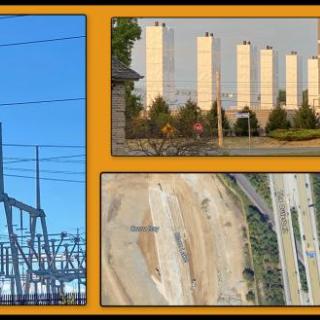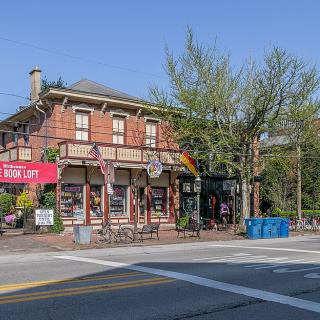Advertisement
The Indianola Presbyterian Church was built in 1916 in the center of Columbus’ historic, once noted and desirable University District. It was known for its architecture (the architect is not named on its website). Its congregation largely consisted of nearby homeowners, many of whom rented rooms to Ohio State University students at a time that OSU had no dormitories. OSU did not build residences on campus until after World War II with its GI Bill-fueled growth.
Contrary to local dangerously misleading mythologies, the area was long shared by homeowners and student tenants. There was no “golden age” of a middle-class mecca of homeowners. There were many students. But there were no large absentee landlords, and the city’s zoning codes regulating the number of properties an individual could own and the number of unrelated individuals living under one roof were actually enforced.
These ahistorical notions have been propagated by Doreen Uhas Sauer, permanent leader of the selectively self-serving University Area Commission, and long-time resident Emily Foster in their publications listed below. They are conclusively refuted by OSU BA and University of Minnesota PhD Ellen Manovich’s doctoral and published scholarship. Both Sauer and Foster were aware of Manovich’s studies when they paid certain publishers to print their unresearched, unfact-checked “books.”
If geographically and architecturally distinctive, the now rhetorically self-described “progressive” Indianola Presbyterian Church is infamous in other fundamental ways. Its long-time leader, William Oxley Thompson, was perhaps the greatest advocate and supporter of racially segregated public schools in Columbus history. Thompson was also a president of The Ohio State University. Its main library bears his name with his portrait hanging inside. An oversized statue of the noted racist stands in front of the library, capping the top of the landmark The Oval.
For more than a generation, members of the OSU and Columbus communities have strongly urged the university to rename the library and move the statue indoors with interpretative contextual information. OSU does not respond to that, nor to the same demands to rename next-door Bricker Hall, the former administration building, also named for a leading local and state racist.
Contradictorily, Indianola Presbyterian Church has an acknowledgement of its location on illegally appropriated Indigenous land centuries before its founding. But there is not one word about Thomspon. We must ask why?
This Indianola church (there are several others on Indianola Ave. itself) shows little awareness of its own history, geography, or past and present relationships. Not only is it not located on Indianola Ave., but its website states also that it is one block “behind” [sic] Buckeye Donuts on N. High St., which did not exist when it was built. It is actually a full two blocks to the east.
This church is a member of the Presbyterian Church of the USA. That denomination was founded in 1973 not 1916. The present version of the church ignores its prior history. For most of its existence, the church would not recognize its current self-presentation and declarations.
Facts do not matter at 1970 East Waldeck Ave. Their stated derivation of “Indianola” itself is fanciful and confused. “Ola” in Spanish means “hello,” not “wave.” Indianola Forest is not an original area designation. Note the church’s self-description copied below.
Contrary to its self-presentation and rhetoric, IPC (as it calls itself) parallels the history of the University District: its founding and long-term stability; its decline over more than 50 years at the hands of the City of Columbus’ anti-Code and Charter zoning variances to larger and larger absentee, for-profit property owners and managers. This transpired and continues with OSU’s knowledge and collusion.
IPC acknowledges neighborhood transition only to a point. It is certainly aware that most of its congregants moved out under the combined forces of urban change, suburbanization, closure of a good public Indianola Middle School two blocks away by the Columbus City Schools which accelerated the exodus of younger families, aging, and deaths. Its congregation is smaller, older, more distant, and unattached to the University District in general and the Waldeck Ave. triangle of intersecting streets of rental housing, fraternities, and sororities in particular.
But the church refuses to accept the basic facts, demands, and responsibilities of a self-declared “progressive” church of absentee clergy and congregants. Most importantly, it neither acknowledges nor takes any responsibilities for its active role as a set of for-profit business enterprises. These sit in the center of absentee landlords mismanaged, no longer “neighborhood” of old and often historic dwellings almost all redeveloped into rented rooms and apartments literally against city codes.
For its contradictory muddle of empty slogans, read IPC’s declarations below. They begin: “We’re progressive and traditional, young and aging, tree-huggers and white collars, open-minded and learning, contemplative and questioning, prayerful, creative, and active. Folks just like you…. We are home to artists and activists, queer and questioning, OSU students/faculty/staff and life-long learners, families and singles, introverts and extroverts, natives and transplants, Neighbors from this neighborhood and from almost all of Columbus’ other neighborhoods.”
Can anyone, including Trip Porch, pastor and/or manager for 3 ½ years, and who does not reside in the University District, tell us what this means?
IPC owns tenant properties. It also initiated and is home to a tuition-based private daycare center and pre-school, and a “public” for-pay private parking lot across the street (except for congregants during Sunday morning services).
IPC no longer has ongoing, interactive, and mutually respectful relationships with remaining homeowners, more than a handful of students including very few nearby temporary tenants), or OSU. The words on its website ring hollowly.
Paralleling the City’s, private landlords’, and OSU’s at least partly illegal destruction of a longstanding, historic, residential neighborhood with a cooperative balance of homeowners and students, IPC has lost its way. Its rhetoric confirms this.
Twenty years ago, the church was much quieter and a less disruptive force than it has become. Both its for-profit “non-profit” daycare and preschool and privately managed for-profit parking lot are hazards,
As to the latter, OSU gameday traffic is a danger to all nearby with no visible authority or traffic management. There are only a few non-church and non-neighbors grabbing money from parkers as quickly as possible. There is no traffic control.
The Indianola Child Center, now approximately 20 years old, has recently become a danger. I have been unable to unravel the relationship between the center and the church inside of which it is located. Apparently, the center began as a part of the church, sponsored and managed by IPC. At present, its director, Anna Long, refers to the pastor and “manager” of the church as her “boss.”
But Porch claims that she is not an IPC employee, and he is not her superior or supervisor. His view is that the IPC and the ICC simply occupy the same building. Regardless, there is at least a clear economic relationship and mutually supporting, coordinated actions.
Despite its tax status as “nonprofit,” the ICC charges $260 to $270 per week plus fees for its enrollees. This is above average for Columbus, and more expensive than Montessori preschools. Its annual licensing compliance inspection record is inconsistent. (See https://childcaresearch.ohio.gov/inspections/407706?q=&p=) Its staff do not list any relevant daycare or preschool educational certifications. No staff other than Anna Long is listed on either ICC or IPS sites. No qualifications or credentials are listed for her, unlike other IPC staff.
During 2023, the center directed parents driving their children to the center/school to park illegally on Waldeck Ave. beside the church’s side door. ICC does this despite the fact that it owns the parking lot directly across the street.
They had the City of Columbus post a Loading sign at the edge of the existing yellow painted, no parking line. They also briefly installed a sign that read Indianola Presbyterian Church Loading Zone. The authority for that was never stated. That object fell over and disappeared.
The problem is that ICC and IPC willfully misread—and therefore misinform the center/school’s fee-payers to violate the law--the applicable City Code to mistakenly justify and promote illegal actions. The relevant section of the Department of Public (i.e., Private) Service Division of Parking Services Loading Zone Rules and Regulations, V. Loading Zones states:
2. Used as a staging area where vehicles are parked temporarily for the loading and unloading of passengers and/or freight.”
This unmistakably refers to school buses, taxis, Ubers and lyfts, and other vehicles pulling over temporarily for passengers to depart the vehicles and for cars and trucks to be unloaded. It does not permit a driver (including a parent) to park, depart from and lock the vehicle, and then walk or carry a child into a school or day care. This typically takes at least 5-10 minutes in a yellow line clearly marked and posted No Parking area. “Loading” and “staging” do not mean “parking.” That is why one sign states “loading,” and another “No Parking.” There is no contradiction. The language and the written code are clear.
These drivers almost never signal before stopping in the loading zone. Many of them do not stop at the nearby stop sign on the northern corner of Waldeck at Woodruff Avenues or Iuka at Waldeck, or use their turn signals.
They endanger the neighborhood, including OSU students walking or riding scooters and bicycles to their classes on the nearby campus.
To use a word from the Presbyterian Church’s own declaration: the IPC must become “reformed.”
How, specifically, do these actions fit into the Indianola Presbyterian Church’s “Who We Are” and “What We Believe”?
We are far from a conclusion to the contradictions of the Indianola Presbyterian Church, a danger to the University District and its residents.
Indianola Presbyterian Church website
“Who We Are”
Founded in 1916, Indianola Presbyterian is a Christian church located in the University District of Columbus (a block behind Buckeye Donuts).
We’re progressive and traditional, young and aging, tree-huggers and white collars, open-minded and learning, contemplative and questioning, prayerful, creative, and active. Folks just like you.
People who are just trying to figure out the mysteries of God, and better understand what all God has do with us.
We are home to artists and activists, queer and questioning, OSU students/faculty/staff and life-long learners, families and singles, introverts and extroverts, natives and transplants, Neighbors from this neighborhood and from almost all of Columbus’ other neighborhoods.
Our worship is casual & informal, and the Spirit moves through classic & contemporary songs, stories, rituals, prayer, and art.
What we believe.Indianola [sic] belongs to the Presbyterian Church (USA) denomination.
We use the full range of scriptural and traditional language, reflecting God’s diversity as feminine & masculine, powerful & vulnerable. We honor the integrity of the cultural language of oppressed people groups, though we may find it unsettling. We seek to imitate Christ’s language of peace and equality amidst the oppressive, patriarchal culture reflected in the Bible.
We speak of inclusion, deliverance, and justice for all people.
and then we believe in following up that belief with our actions.
The PC (USA) affirms all LGBTQ people and defines marriage as a lifelong covenant between any two people.
Land Acknowledgement
Indianola Presbyterian Church occupies the ancestral and contemporary lands of the Shawnee, Potawatomi, Delaware, Miami, Peoria, Seneca, Wyandotte, Ojibwe, and Cherokee peoples [citation]. The church resides on land ceded in the 1795 Treaty of Greeneville and the forced removal of tribal nations through the Indian Removal Act of 1830. Even our name “Indianola” (originally chosen for the church because we are situated in the historic neighborhood “Indianola Forest”) derives its origin from the word “Indian” and the Spanish Word “ola” or “wave.” We are committed to not only acknowledge the wrong done to the native peoples of this land, but also heal and repair that wrong as we advocate for their rights and their welfare in this country.
We believe in putting our faith into action. Together, we strive to address the needs of those who are marginalized in our neighborhood and city. Each Week, we collect and donate food to Neighborhood Services Inc., our neighborhood food pantry. Motivated by the climate crisis and our love for creation we became an Earth Care Congregation committed to doing our part to stop climate change, reduce waste, and ensure our planet’s future welfare. national and international crises involving refugees, immigrants, and asylum seekers, we became a sanctuary church and continue to serve and support those affected by these issues.
Trip Porch, Pastor
- Trip has been pastor at Indianola since July 2020. He and his family (Brittany, Ward, and Arden) live in Clintonville and loving [sic] being rooted here in the diverse, creative, vibrant city of Columbus.
Trip grew up in the beach town of Pensacola, FL where he received a foundation in the arts, academia, the underground punk scene, coffee houses and the justice work of the civil rights movement. He received his B.A. from Florida State University and M.Div. from Columbia Theological Seminary in Decatur, GA.
University District references
Foster, Emily, ed. (2014) The Ohio State University District: A Neighborhood History.
Charleston, SC: The History Press
Manovich, Ellen (2016) “‘Is This a Real Neighborhood’: Universities, Urban Development, and
Neighborhood Change in the 20th Century United States,” unpublished Ph.D. Diss.,
University of Minnesota
_____. (2018) “‘Time and Change Will Surely Show’: Contested Urban Development in Ohio
State’s University District, 1920-2015,” Journal of Social History 51 , 1069-1099.
Sauer, Doreen N. Uhas and Stuart J. Koblentz, eds. (2009) The Ohio State University
Neighborhoods. Charleston, DC: Arcadia.
By Harvey J. Graff
“The decline of a once vital neighborhood: Columbus’ University District,” Columbus Free Press, Sept 14, 2021
“Columbus’ University District: Students and the institutions that fail them,” Columbus Free Press, Oct. 8, 2021
“How Columbus, Ohio State University, and major developers destroyed a historic neighborhood,” Busting Myths, Columbus Free Press, Part One, Apr. 26, 2022
“How Columbus, Ohio State University, and major developers destroyed a historic neighborhood,” Busting Myths, Columbus Free Press, Part Two, Apr. 29, 2022
“How Columbus, Ohio State University, and major developers destroyed a historic neighborhood—A continuing legacy,” Busting Myths, Columbus Free Press, May 2, 2022
“Columbus’ anachronistic, private interest-dominated ‘area commissions’ and ‘neighborhood
organizations’ must go,” Busting Myths, Columbus Free Press, Dec. 3, 2022
“Columbus’ home-grown illegal landlords in a destroyed historic district,” Busting Myths,
Columbus Free Press, Dec. 11, 2022
“The plague city: Daily life in Columbus, Ohio,” Busting Myths, Columbus Free Press, Dec. 17, 2022
“Universities and cities often fail both homeowners and students,” Times Higher Education, Jan. 22, 2023
“A city versus its neighborhoods: Columbus, Ohio,” Busting Myths, Columbus Free Press, Jan.
25, 2023
“J’accuse: The City of Columbus Division of Public (aka Private) Service,” Busting Myths,
Columbus Free Press, Mar. 3, 2023
“A call for reparations from the City of Columbus, the large corporate landlords, and The
Ohio State University for the destruction of neighborhoods with a focus on the
University District,” Busting Myths, Columbus Free Press, Apr. 1, 2023
“The plague of Columbus’ streets and sidewalks: Electric scooters illegally fueled by the
City’s Division of Public (aka Private) Services,” Busting Myths, Columbus Free
Press, Apr. 14, 2023
“Lawless, Unsafe, and Dirty: The Dying University District.” Busting Myths, Columbus
Free Press, May 2, 2023
“Ohio State University and its Dying University District: The Oval and the Campus
Beyond,” Busting Myths, Columbus Free Press, May 5, 2023
“The broken, no—the evil—triangle of the City of Columbus vs. its residents. Destroying the
physical city and the semblance of neighborhoods: Zoning (Un)enforcement, Public (Private) Service, and 311, with the assistance of OSU, the City Attorney, CPD, City Council, and Mayor, Part One,” Busting Myths, Columbus Free Press, Aug. 4, 2023
“The broken, no—the evil—triangle of the City of Columbus vs. its residents. Destroying the
physical city and the semblance of neighborhoods: Zoning (Un)enforcement, Public (Private) Service, and 311, with the assistance of OSU, the City Attorney, CPD, City Council, and Mayor, Part Two,” Busting Myths, Columbus Free Press, Aug. 8, 2023
“Emergency Bulletin: The City of Columbus, OSU, and landlords against student tenants and
homeowners—dramatic case in point,” Columbus Free Press, Aug. 21, 2023
“Columbus is lost among midwestern metropolises. Can it learn from others and finally begin to find itself? Or is it too late?” Busting Myths, Columbus Free Press, Oct. 4, 2023.
------------------------------------------------------------------
Harvey J. Graff is Professor Emeritus of English and History, inaugural Ohio Eminent Scholar in Literacy Studies, and Academy Professor, Ohio State University. Author of many books on literacy, children and youth, cities, and interdisciplinarity, most recently he published Searching for Literacy: The Social and Intellectual Origins of Literacy Studies (2022). My Life with Literacy: The Continuing Education of a Historian. The Intersections of the Personal, the Political, the Academic, and Place is forthcoming. “Reconstructing the new ‘uni-versity’ from the ashes of the ‘multi- and mega-versity’” is in progress. He is also editing Changing Paths of Academic Lives: Revising How We Understand Higher Education/Universities, 1960s to 2020s and Beyond, a collection of original essays.



